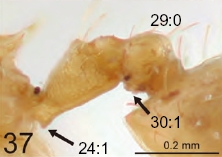Crematogaster luzonensis
| Crematogaster luzonensis | |
|---|---|

| |
| Scientific classification | |
| Kingdom: | Animalia |
| Phylum: | Arthropoda |
| Class: | Insecta |
| Order: | Hymenoptera |
| Family: | Formicidae |
| Subfamily: | Myrmicinae |
| Tribe: | Crematogastrini |
| Genus: | Crematogaster |
| Species group: | biroi |
| Species: | C. luzonensis |
| Binomial name | |
| Crematogaster luzonensis Hosoishi & Ogata, 2016 | |
Nothing is known about the biology of Crematogaster luzonensis.
Identification
Hosoishi and Ogata (2016) - In the worker this species can be distinguished from all other members of the Crematogaster biroi group by the scape with suberect to decumbent setae, distinct compound eyes, generally smooth dorsal surface of head, and sparse erect and stout setae on body. This species is similar to Crematogaster fritzi, but can be distinguished from it by the suberect to decumbent setae on scape, shorter setae on anterior mesonasal ridge, abundant erect setae on fourth abdominal tergite.
Keys including this Species
Distribution
Distribution based on Regional Taxon Lists
Indo-Australian Region: Philippines (type locality).
Distribution based on AntMaps
Distribution based on AntWeb specimens
Check data from AntWeb
Countries Occupied
| Number of countries occupied by this species based on AntWiki Regional Taxon Lists. In general, fewer countries occupied indicates a narrower range, while more countries indicates a more widespread species. |

|
Estimated Abundance
| Relative abundance based on number of AntMaps records per species (this species within the purple bar). Fewer records (to the left) indicates a less abundant/encountered species while more records (to the right) indicates more abundant/encountered species. |

|
Biology
Castes
Worker
 
| |
| . | |
Nomenclature
The following information is derived from Barry Bolton's Online Catalogue of the Ants of the World.
- luzonensis. Crematogaster luzonensis Hosoishi & Ogata, 2016a: 585, fig. 106 (w.) PHILIPPINES (Luzon).
- Type-material: holotype worker, 4 paratype workers.
- Type-locality: holotype Philippines: Luzon, 25.iv.1992, PH64 coconut (M.J. Way); paratypes: 1 worker with same data, 3 workers Luzon, 2.v.1992, PH81 coconut (M.J. Way).
- Type-depositories: BMNH (holotype); CASC, KUEC, MHNG, NMPM (paratypes).
- Distribution: Philippines (Luzon).
Unless otherwise noted the text for the remainder of this section is reported from the publication that includes the original description.
Description
Worker
(n = 5): HW 0.41–0.46; HL 0.42–0.46; CI 96–100; SL 0.36–0.42; SI 88–95; EL 0.11–0.13; PW 0.26–0.29; WL 0.49–0.55; PSL 0.07–0.1; PtL 0.15–0.17; PtW 0.13–0.16; PtH 0.11–0.13; PpL 0.09–0.11; PpW 0.15–0.17; PtHI 71–81; PtWI 87–94; PpWI 145–178; WI 100–114.
Workers monomorphic. Head subquadratic in full-face view. Mandibles with four teeth arranged at an equal distance, apical and subapical teeth large, basal two teeth smaller. Anterior clypeal margin convex in medial portion. Compound eyes distinctly projecting beyond lateral margins of head in full-face view. Scapes reaching posterolateral corners of head.
Pronotal collar with almost straight anterior margin in dorsal view, distinctly lower than pronotum in lateral view. Pronotal dorsum with feeble ridges laterally. Mesonotal dorsum with lateral ridges that irregularly extend posteriad to tips of propodeal spines. Pronotum and mesonotum in lateral view forming slightly convex, continuous dorsal outline. Metanotal groove in dorsal view transverse, almost straight in median portion, forming deep concavity that is laterally margined by lamellate ridges. Propodeal spiracles oval, situated at posterolateral corners of propodeum, apart from metapleural gland bullae. Propodeal spines developed, longer than diameter of propodeal spiracles, in dorsal view directed posteriad.
Petiole in dorsal view with subparallel sides and narrow anteriorly, longer than wide. Posterior portion of petiole with short process that is slightly higher than posterior margin of petiole disc in lateral view. Subpetiolar process developed as blunt process. Postpetiole in lateral view with weakly convex dorsum, as high as petiole, in dorsal view as wide as or slightly wider than petiole, weakly bilobed posteriorly but without longitudinal sulcus. Subpostpetiolar process developed bluntly.
Integument essentially sculptured. Dorsal surface of head generally smooth, but with rugulae on surrounding region of antennal sockets. Mandibles with feeble rugulae and smooth interspaces. Clypeus generally smooth, but with one distinct pair of longitudinal rugulae and one pair of feeble rugulae; distinct rugulae extending to posterior clypeal margin. Anterolateral shoulders of pronotum with rugulae. Lateral surface of pronotum smooth and shining. Pronotum and mesonotum with longitudinal rugulae and sculptured interspaces. Mesopleura weakly sculptured. Rugula on higher portion of mesopleura weakly developed. Dorsal surface of propodeum generally smooth and shining, but one pair of rugulae running from metanotal groove extending posteriorly and diverging to tips of propodeal spines. Dorsal surface of petiole generally smooth. Lateral surface of petiole sculptured. Dorsal and lateral surfaces of postpetiole weakly sculptured.
Standing pilosity sparse. Dorsal face of head with some pairs (c. 8) of erect and stout setae, and short and decumbent setae sparsely. Clypeus with two pairs of long and stout setae in anterior portion, one directed upward and the other downward. Anterior clypeal margin with one pair of long setae medially and some pair of short setae laterally. Scapes with decumbent setae. Mesosoma with five pairs of long erect and stout setae (ps1PN, psaMN, pspMN, ps1PS, and ps2PS) that are much longer than other erect setae. Posterolateral tubercles of petiole posteriorly with one pair of stout setae. Postpetiole with three pairs of stout setae on disc antrodorsally, anterolaterally and posteriorly. Fourth abdominal tergite with some pairs (c. > 10) of erect and stout setae, and short appressed seate sparsely.
Body yellow. All flagellar segments yellow.
Type Material
Holotype worker. Luzon, PHILIPPINES, 25.iv.1992 (PH64 coconut) (M. J. Way) (The Natural History Museum).
Paratypes. One worker, same data as holotype (National Museum of the Philippines); three workers, Luzon, PHILIPPINES, 2.v.1992 (PH81 coconut) (M. J. Way) (California Academy of Sciences, Entomological Laboratory and Institute of Tropical Agriculture, Faculty of Agriculture, Kyushu University, Musee d'Histoire Naturelle Genève).
Etymology
The specific name refers to the island of origin, Luzon.
